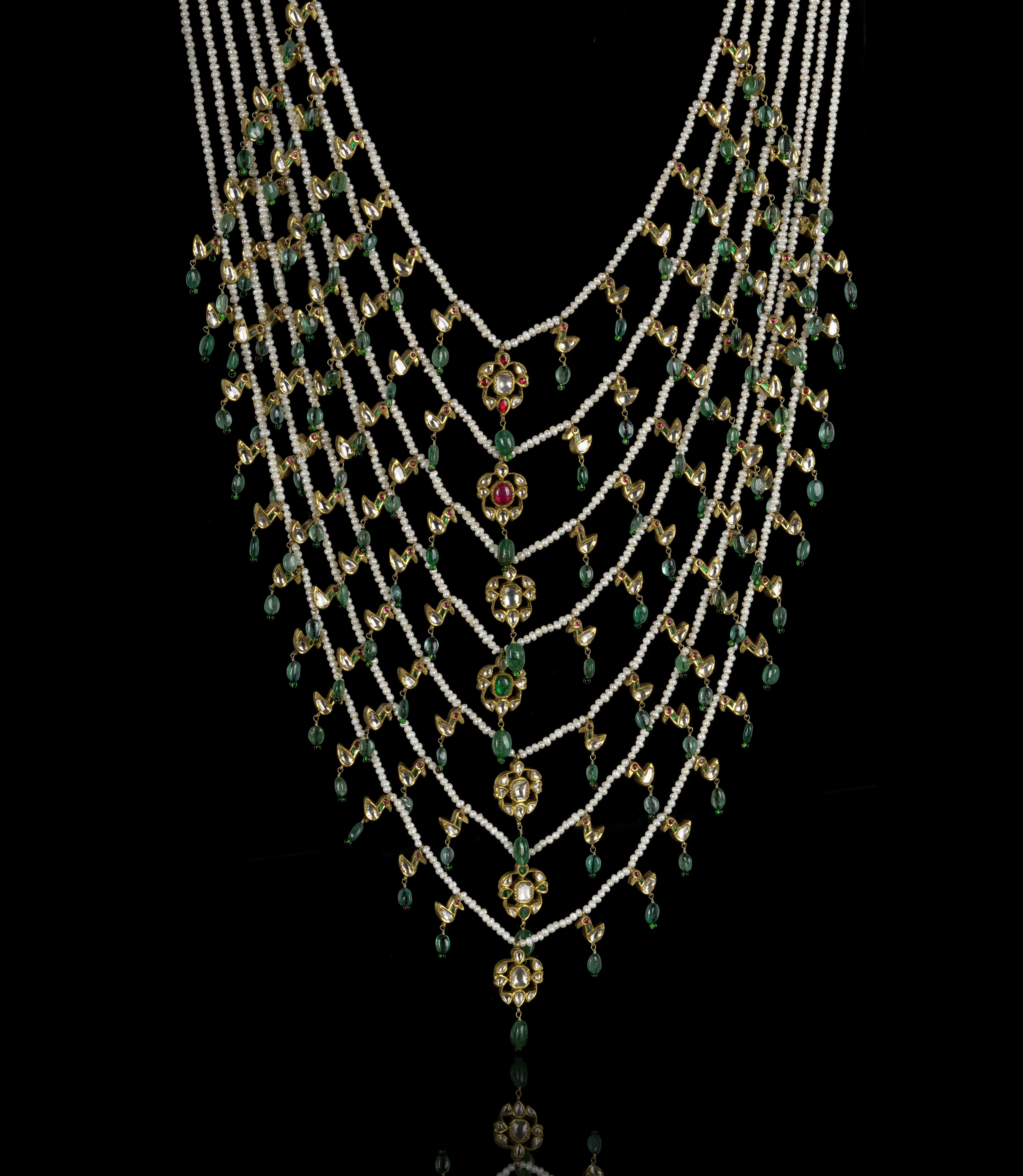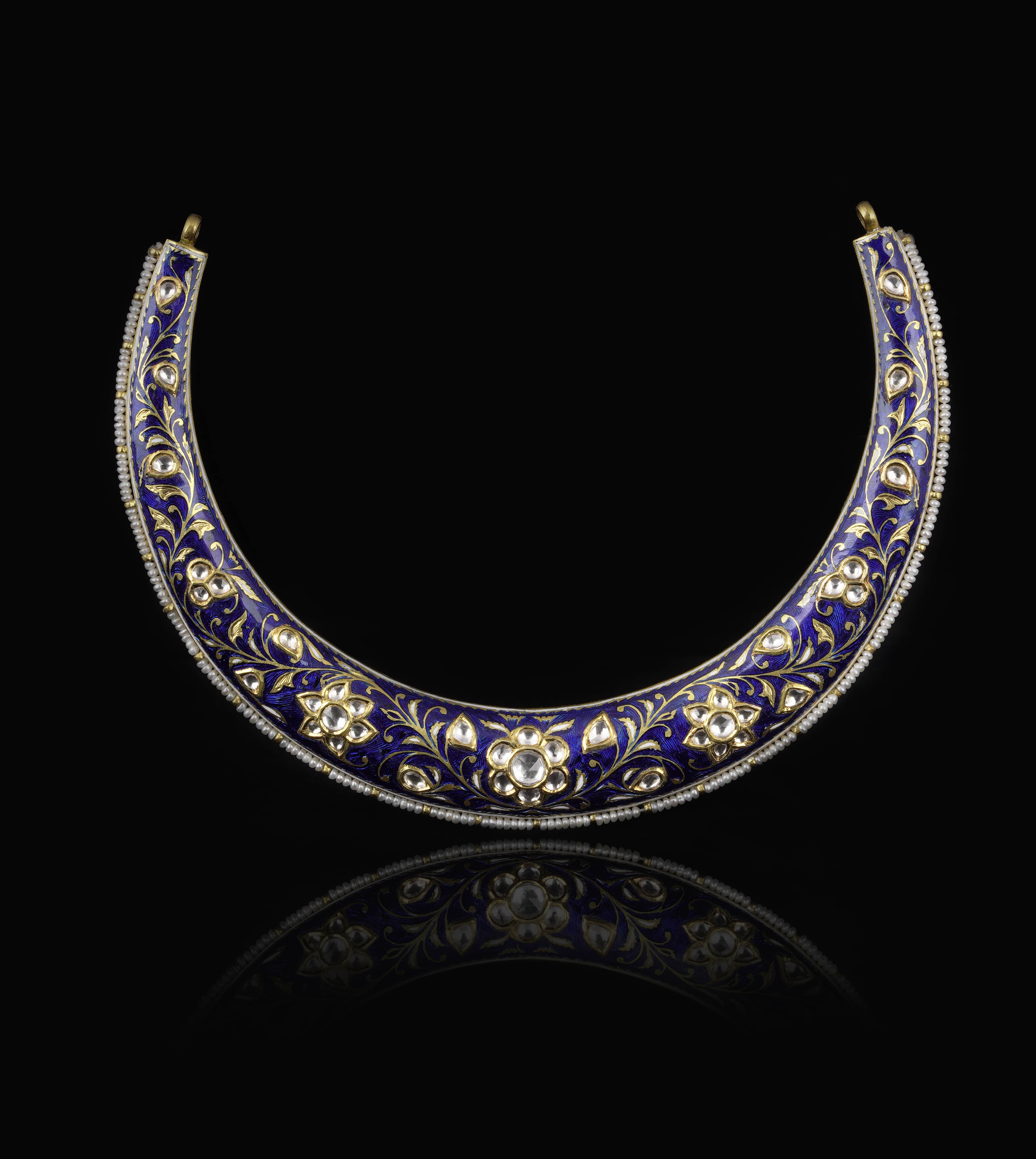Ahmedabad-based duo, Puja and Kunal Shah, co-founders of fine jewellery brands, Aurus and Moi, have embarked on a serendipitous journey to curate Indian Family Jewels, a digital-first project commissioned to the creative expertise of Border&Fall for the creation of an open-source and inclusive platform.

The project is an effort to impart knowledge on the distinction of India’s precious jewellery, recognising many of its roots including tribal, agrarian, cultural, trade based, or royal. Often, pieces were created in other materials which later became more elaborate, made in gold and precious stones. Currently, many pieces are created incorporating elements borrowed from multiple styles or imagined entirely new through contemporary avatars. Today, most are worn without original intention, signifying that jewellery continues to assume its rightful role as a product of our culture, adapting and changing over time. With this undertaking, the intention of the creators is to document the origins and narratives around jewellery from India.
Contentious narratives, lack of documentation and a repository so large it is effectively immeasurable. This is not a definitive document but rather, a beginning of a conversation, sharing information of both the familiar and lesser known. The project will therefore also invite individuals to layer it with their personal stories and anecdotes, transforming it into a powerful shared resource. The cultural documentation will work as an open invitation to the community to help populate real stories and historical narratives associated with jewels from India. This endeavour comes at a crucial point in time when a New India is emerging and with it, a renewed interest of younger generations to embrace their roots. Over the last century, lots of Indians have migrated within and outside the country. For many, their language, food, and rituals remain as the only source of connection with where they belong. From a material memory standpoint, textiles and jewellery are important pieces of that puzzle.
Through this project, Puja and Kunal wish to place the spotlight on jewellery and use Indian Family Jewels as a platform to initiate conversations using a digital-first medium to talk about all things jewellery while making it relatable to today’s younger generation. India’s brush with fine jewellery started a few centuries ago with patronage from the royal families and subsequently flowed to other families with resources to afford the investment. A lot of emphasis was placed on the skill of the artisans. Various craft techniques were carefully supported and developed. There was the use of high-quality gemstones that brought a lot of beauty to the jewels. Over the last few decades, Indian jewellery has become more of a luxury commodity.
The focus seems to have shifted from skilled craftsmanship and attention to detail to more commercially viable and trend-based designs. In that din, the artisans had to move from nuanced to commercial work. IFJ is an attempt at reawakening the awareness of India’s diverse regional jewels and the techniques/craft that makes them special, by capturing and cataloguing the various types of jewellery across the country with a spotlight on the distinct forms, the artisans, the techniques, and the design language. Beginning with seven neckpieces specifically associated with weddings, this is the first step in a larger undertaking intended to further document jewellery categories across India.

Below are six key pieces from the series:
1. Satlada: A symbol of nobility, the name Satlada is contingent on the number of strands on the necklace. A seven-strand pearl necklace, increasing in length consecutively, made with pearls and pendants, the Satlada is one of the finest examples of Mughal jewellery. One of the historic versions, owned by the Nizams of Hyderabad, was known to have 465 pearls. This elaborate necklace was regarded as an index of family wealth and prestige in the olden days and was typically presented by the mother-in-law at the wedding ceremony.
2. Hasli: Deriving its name from the Hindi word 'hansuli' meaning 'collar bone', this traditional neckpiece is believed to have first been worn by women in Gujarat and Rajasthan. Often crafted in silver and gold, the Hasli is rigid in form and tapers towards the end in the form of a collar necklace. The gold is more elaborate, often embellished with precious gems like rubies or turquoise and kundan.
3. Pankhi Haar: During the Mughal reign many new sophisticated pendant forms were developed, including the Pankhi – a traditional handheld fan. The necklace consists of a single chain to which multiple pankhis are hooked. The design often incorporates elements of nature, predominantly birds, with two parrots perched together symbolizing the profound bond between female friends or features the Sri Nath Krishna motifs in some cases. To this day, the main centre for the production of such jewellery remains in Jaipur, Rajasthan.
4. Guluband: Traditionally worn by Hindu brides and Bharatanatyam dancers, the Gulubad rose to prominence during the Mughal & Nizam rule. The name is derived from two words, the ‘Gala’ meaning neck and 'bandh' (to close). This necklace of small individual panels, each set with different gemstones, metals, or enamel is strung tightly together to form a choker. It is most often seen across the country in Tamil Nadu, Karnataka, Gujarat, Rajasthan, Punjab, Bengal, Maharashtra and Uttarakhand.

5. Lokaparo: Noted to be a symbol of peace, the Lokaparo gets its name from ‘Paro’ meaning pigeon - the central motif which hangs as a pendant. The design often features two identical pigeons symmetrically placed back-to-back signifying good luck and auspiciousness. The usual gold embellishments are enhanced by precious stones like rubies, emeralds, kundan or polki. Traditionally donned by high-profile male dignitaries of the Ahom dynasty, today the neckpiece is quintessential to an Assamese bridal trousseau.
6. Thali: With its origins in Tamil Nadu, the Thali features one or more pendants with four sharp spikes, which represent the four Vedas, symbolising knowledge. The name is derived from the term for the Palmyra Palm plant (Thala) and is used as a reference to the ancient custom of tying strips of palm leaves around the neck of a married woman to indicate her marital status. At weddings, the groom would tie this necklace around the bride's neck after the exchange of vows. It has been worn as a protective amulet by the bride and a symbol of the groom's responsibility towards the family's well-being. However, present-day narratives have increasingly contested the value of these types of necklaces as symbols of patriarchy.

Puja Shah, co-curator of Indian Family Jewels, says: “Jewellery is more than just an object of adornment, especially in a country like India where almost every creation has some sort of meaning attached to it, be it economical, social, or spiritual. For some, it is a family memoir; for others, it is a way to stay connected with their roots as they move away from their hometown or country. For me, the Kaliganthi necklace is a representation of my culture and my history. And I, along with a lot of people, believe that a Gujarati bride should consider the necklace as her cultural heritage. And so should other such necklaces of different cultures and regions be part of the cultural heritage of the bride belonging to that culture and/or region.”
Kunal Shah, co-curator of Indian Family Jewels, says: “As we built our online presence in fine jewellery, we engaged with a lot of young brides from different regions of India and residing outside of India, and a single thread that was common in most conversations was around where they came from. They wanted to understand and follow their specific cultural traditions and customs. They were going back to their mums and grandmoms to understand the significance of those customs. In that sense, it was personal learning that jewellery is not just to adorn oneself but an important material memory keeper. It represents the times it was made in, but more importantly, it becomes a marker for future generations. Most of our fine jewellery history is in academic tomes. And that's where our project started taking form. Indian Family Jewels are our bit to document our jewellery heritage in a format calibrated for the digitally native.”
Malika V Kashyap, founder, Border&Fall, says: "Indian Family Jewels is an enchanting endeavour that documents the cultural significance of our precious jewellery. Created as an open and inclusive platform, the project invites individuals to layer it with their personal narratives, transforming it into a powerful shared resource."
Be the first to comment